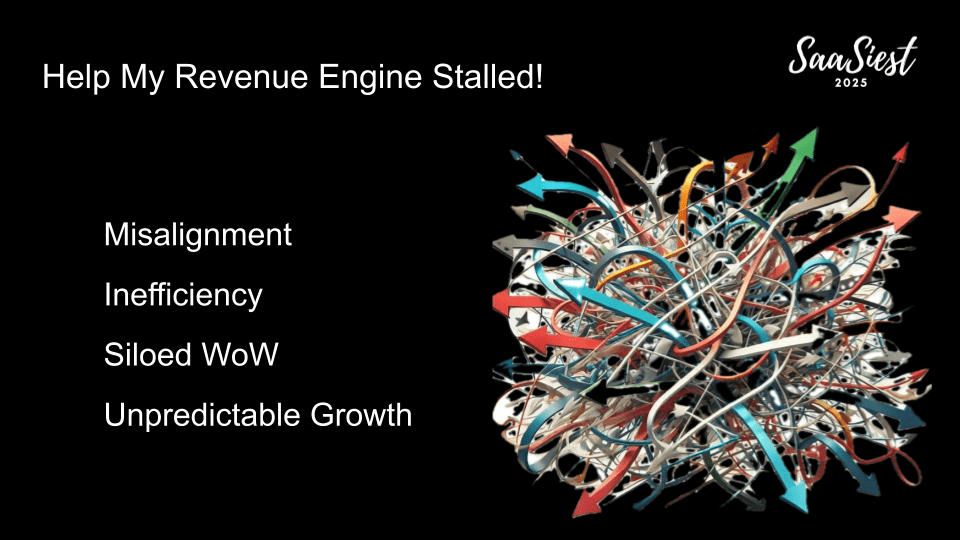Lessons from Zensai CRO Kathleen Lord at SaaSiest 2025
As SaaS businesses grow beyond €5–10M in ARR, complexity creeps in. Revenue becomes harder to predict. Teams start to operate in silos. Growth plateaus—not because of product-market fit, but because internal alignment hasn’t scaled with the company.
At SaaSiest 2025, Kathleen Lord—Chief Revenue Officer at Zensai and former CRO at Intacct (scaled from $2M to $200M ARR)—laid out a clear, experience-based solution: the Revenue Operating Model (ROM).
This article summarizes the key takeaways from her talk, including:
- What a ROM is and why it matters from €2M to €200M in ARR
- How to implement one (with a 7-step blueprint)
- Practical insights for functional leaders to drive scalable, predictable growth
This isn’t theory. It’s what experienced operators are doing right now to fix growth plateaus—without overhauling everything.
Why ROMs Matter—and Why So Few Companies Have One
A Revenue Operating Model (ROM) is the blueprint that governs how your revenue engine works. It aligns GTM teams—sales, marketing, customer success, product, and RevOps—on:
- Who you’re targeting (ICP, segments, value props)
- How you sell (processes, cadences, forecasting)
- How you grow (expansion, retention, repeatability)
When growth is unpredictable, ROMs bring clarity and rhythm. According to Forrester, companies with strong revenue operations alignment grow 19% faster and are 15% more profitable.
Yet, many scaleups delay this level of structure, assuming it’s only for later-stage companies. Kathleen argues that’s a mistake: “The earlier you implement a ROM, the easier it is to scale efficiently.”

Inside the ROM Rollout at Zensai
When she joined Zensai, the company had just transitioned from LMS365 to a broader platform with multiple products and personas. ARR was around $30M USD, and growth was largely fueled by a strong 95% inbound motion.
But the company faced classic growing pains:
- No outbound muscle
- Regional GTM teams operating independently
- Inconsistent use of CRM and forecasting tools
- Lack of expansion playbook beyond initial sales
Despite these headwinds, Zensai added $10M in ARR over the next seven months—while undergoing a company-wide ROM transformation.
This was not a “rebuild everything” scenario. As Kathleen puts it:
“We performed a heart transplant while running a marathon.”
The secret was a phased, pragmatic implementation focused on unifying process, cadence, and culture—without stifling individual teams.
The 7-Step Blueprint: Building Your ROM
Whether you’re a €5M ARR company professionalizing GTM for the first time or a €100M company looking for scale, this blueprint applies.
1. Define Your North Star
Start with a shared ambition. This includes:
- Company-level growth goals
- Your Ideal Customer Profile (ICP)
- Clear segmentation strategy (SMB vs Enterprise)
This becomes the foundation for all commercial motions.
2. Design the ROM Framework
Map your revenue process end-to-end:
- Lead → Opportunity → Close → Onboard → Expand
- Standardize key GTM processes (e.g., deal reviews, QBRs)
- Define the customer lifecycle and ownership model
This framework helps eliminate grey zones and duplicated work.
3. Standardize Cadence and Forecasting
Create rhythm across your organization:
- Weekly 1:1s and pipeline reviews
- Monthly regional performance huddles
- Quarterly business reviews and forecast validations
Pro tip: What’s not in the CRM doesn’t exist. Forecasts should be data-driven and inspectable.
4. Invest in the Tech Stack (Strategically)
Use tools to reinforce behaviour, not replace it:
- Make good process the path of least resistance
- Avoid “Frankenstein stacks”—opt for fewer tools used well
- Align tooling to how you want the team to operate
Kathleen highlights the importance of RevOps here: “You can’t scale past €50M ARR without serious RevOps leadership.”
5. Enable the Team
Training is not one-size-fits-all. Role-specific enablement is essential:
- SDRs need prospecting frameworks
- AEs need deal stage fluency and CRM discipline
- Managers need tools to coach and inspect
Don’t skip frontline managers. They are the transmission engine of your ROM.
6. Launch with Intent
Treat ROM rollout like a product launch:
- Global alignment from leadership
- Regional adaptations where needed
- Reinforce individual-level benefits: better attainment, cleaner forecasts, faster ramp
This helps avoid resistance and encourages adoption.
7. Institutionalize Through Coaching and Metrics
It’s not a one-time rollout. Embed ROM through:
- Quarterly reviews of what’s working and what’s not
- A central documentation hub for self-service
- Celebrating quick wins (e.g., expansion success stories, time-to-ramp improvements)
What Happens When It Works
Done right, a ROM delivers measurable results across key dimensions:
| Impact Area | Outcome |
| Forecast Accuracy | Improved by up to 20–30% in mature teams |
| Sales Velocity | Reduces time-to-close by 10–15% |
| Churn & Expansion | Creates ownership and consistency in CS |
| Ramp Time | Reduces AE/CSM ramp by 2–4 weeks |
| Leadership Visibility | Faster, more confident strategic decisions |
It also creates a platform for effective change management. When the market shifts, you have a playbook and cadence to adapt—not chaos.
Takeaways for SaaS Leaders and Investors
For functional leaders (VPs of Sales, Marketing, CS, RevOps), the ROM is a blueprint to scale without chaos. It’s not about over-engineering—it’s about being intentional and repeatable.
For investors, especially those supporting companies in the €10–100M ARR range, the ROM is a diagnostic tool. Do portfolio companies have one? If not, where’s the friction?
Key Questions to Ask:
- Are go-to-market teams aligned on ICP and lifecycle?
- Is there a shared forecasting and performance cadence?
- Are roles and motions clearly defined across the funnel?
- Does RevOps have a seat at the leadership table?